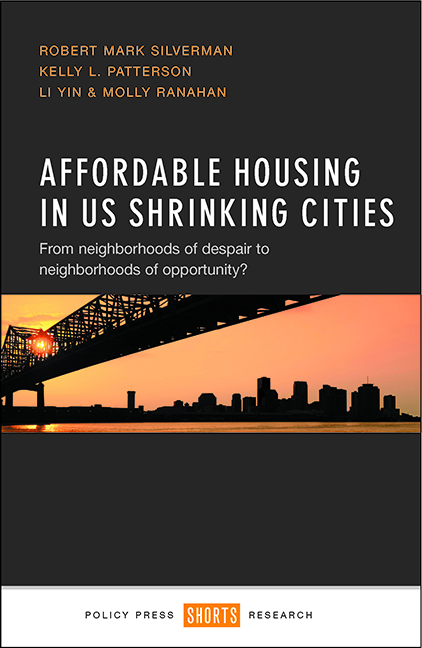 Affordable Housing in US Shrinking Cities
Affordable Housing in US Shrinking Cities Book contents
- Frontmatter
- Contents
- List of tables
- List of figures
- List of acronyms
- About the authors
- Acknowledgments
- Preface
- 1 Social equity and siting affordable housing in shrinking cities
- 2 Present-day Detroit
- 3 Present-day New Orleans
- 4 Present-day Cleveland
- 5 Present-day Pittsburgh
- 6 Present-day Buffalo, New York
- 7 Lessons learned and recommendations for siting affordable housing
- References
- Index
4 - Present-day Cleveland
Published online by Cambridge University Press: 01 September 2022
- Frontmatter
- Contents
- List of tables
- List of figures
- List of acronyms
- About the authors
- Acknowledgments
- Preface
- 1 Social equity and siting affordable housing in shrinking cities
- 2 Present-day Detroit
- 3 Present-day New Orleans
- 4 Present-day Cleveland
- 5 Present-day Pittsburgh
- 6 Present-day Buffalo, New York
- 7 Lessons learned and recommendations for siting affordable housing
- References
- Index
Summary
Introduction
This chapter examines Cleveland’s approach to urban revitalization. The chapter begins with a discussion of the city’s and region’s population decline during the postwar period. This decline was rooted in structural shifts in Cleveland’s traditional manufacturing base and emerging regional development patterns. This discussion highlights how Cleveland, despite decline, was relatively advantaged among its peer shrinking cities, since it had a dense network of public, private, and nonprofit organizations to draw from as revitalization was planned and implemented. In particular, we describe how Cleveland gained a national reputation for equity planning and community-based development during the postwar period. The presence of an equity ethos in the city and a dense network of nonprofit intermediaries and community development organizations helped promote more sustainable neighborhood revitalization. Cleveland’s approach to eds and meds developed against this backdrop. As a result, the benefits of this strategy are more visible in neighborhoods surrounding anchor institutions.
After discussing Cleveland’s decline and its urban revitalization policies, data for population and housing characteristics are presented to contextualize the city’s experience. These data reveal that, despite sustained efforts to revitalize the core city, population loss was persistent in Cleveland. It is argued that, to some degree, urban revitalization stabilized the city’s eds and meds districts, but these improvements did not have a noticeable impact on residents’ access to affordable housing and employment citywide. Moreover, residents had less access to some types of subsidized housing in revitalized areas. This was a particularly problematic issue with respect to households receiving rent vouchers. The implications of these findings are discussed in more detail in the final section of the chapter.
Cleveland in the wake of sustained shrinking
Where things stand in Cleveland
Current conditions in Cleveland are the outgrowth of decades of deindustrialization and subsequent urban decline. The city began to realize population losses in the postwar period, however some trace the beginning of the city’s decline to the 1930s (Fogarty and Garofalo 2014). This is because the city’s population first peaked in 1930 at 900,429 residents, then it had a slight resurgence during the Second World War due to a spike in employment related to war production. Stepped-up industrial activity during the war caused the population to peak again in 1950. Like other shrinking cities, Cleveland also experienced uneven regional development during the postwar period, with core city decline and suburban growth occurring simultaneously.
- Type
- Chapter
- Information
- Affordable Housing in US Shrinking CitiesFrom Neighborhoods of Despair to Neighborhoods of Opportunity?, pp. 71 - 96Publisher: Bristol University PressPrint publication year: 2016


